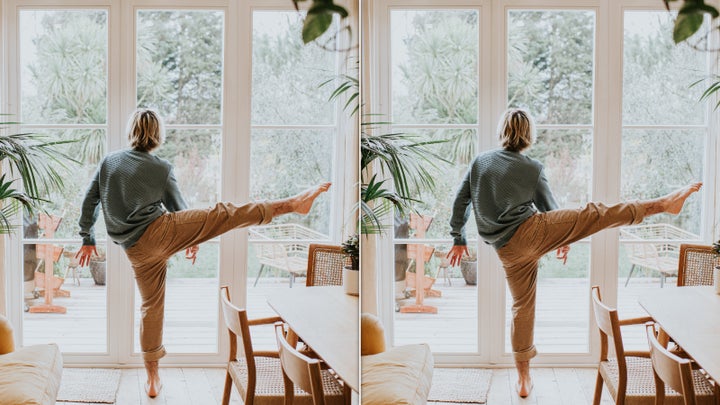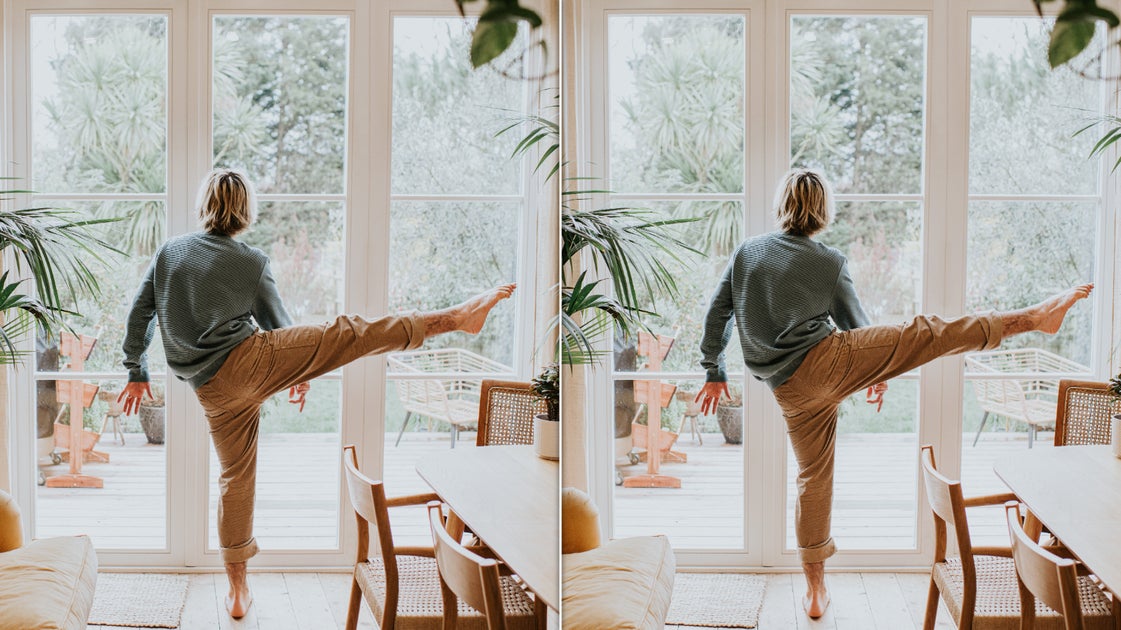How much time do you spend intentionally balancing on one foot? If you’re like most people, probably not much ― but experts say you should challenge yourself to (safely) do so.
Having the ability to balance on one leg is important for several reasons. While it may seem like an arbitrary movement, balancing on one leg is something we do every single day, like when we’re walking, explained Dr. Gillian Wooldridge, a sports medicine physician at Houston Methodist Hospital.
When you’re walking, “temporarily, you are balancing on one leg as you step from one foot to the other, or going up and down stairs,” Wooldridge said. “If we don’t have good balance, we’re not able to do those things effectively, and that can increase our risk for falls.”
Falls can be a life-altering occurrence, particularly for older adults, said Amanda Beaty, a physical therapist at Duke Health in North Carolina.
“Preventing falls is going to eventually lead to a longer life, and a more healthy life because you’re not suffering from these injuries that could then reduce your mobility,” Beaty said, adding that falls can take away an older adult’s independence and cause anxiety when doing day-to-day tasks.
Beyond fall risk, balance also reveals a great deal about our overall health.
“There are certain health conditions that can negatively impact our balance,” said Beaty, including diabetes, osteoarthritis, joint pain and heart disease.
“It’s kind of a two-way street. If we’re healthier, our balance is probably better. And if we can maintain our balance, we’re probably more active so then we can maintain a healthier body and have better longevity and be less frail,” Beaty added.
There are many reasons to prioritize your balance and work on it if it’s not up to par. Below, experts share how long you should be able to balance and what you can do to improve it:
How long you should be able to balance on one leg varies, but at least 10 or 15 seconds is the minimum.
The exact amount of time you can balance on one leg depends on several factors, including age and health conditions.
“But one number that often gets quoted is if you are unable to balance on one leg for more than 10 seconds, it’s very likely that you are at increased fall risk and actually could even potentially indicate an increased risk of dying in the next decade,” said Wooldridge.
Beaty took this number just a little higher and said that folks should aim to hold to their balance for at least 15 seconds. Studies examining single-leg balance have found that older adults who can maintain their balance for at least 15 seconds experience better health outcomes.
“If you could hold your balance for at least 15 seconds, that predicted a lower risk of recurrent falls,” Beaty explained.
These 10 and 15-second goals are more for older adults.
“The younger you are, the longer you should be able to balance on one leg,” added Wooldridge.
It’s often said that people under 30 should be able to balance on one leg for 40 to 45 seconds, while those between 30 and 50 years of age should aim for 30 seconds, Wooldridge said.
Regardless of your age, if you struggle with balance, consult your doctor. Recurrent falls in your 30s and 40s aren’t normal; it’s crucial to seek medical advice if you’ve experienced this, Beaty noted.
 Balancing on one leg is important for healthy aging.
Balancing on one leg is important for healthy aging.
How to improve your balance
There are a number of movements, exercises and habits that can help improve or maintain balance, but Beaty said the most important thing is to practice in a safe manner.
If you’ve had falls or notice a change in balance, see a physical therapist or primary care doctor who can come up with a safe plan for improvement, Beaty said. This way, you won’t injure yourself at home.
If you are in a position to work on your balance at home, one safe way to do so is by using your kitchen countertop as a support.
“A safe way to try that at home, is just holding your balance, but at a countertop where you can hold on with your hands, and then gradually trying to reduce the amount of hand support that you need to maintain that balance on one leg,” Beaty said.
Start by standing on one leg while holding the countertop and try to take your hands away from the counter for five seconds and build from there. You can also try this near a dining room table, desk or dresser, which can also provide support in case you become unsteady.
Beyond a direct standing-on-one-leg challenge, exercise of any kind (walking, swimming, biking) is also a good way to improve your balance, according to Beaty.
“People who are more physically active and physically fit are going to also be at a lower risk for falls,” Beaty said.
In addition to aerobic exercise, strength training is also important for building up and maintaining balance.
“Muscle strength is always going to be important. I tell my patients the best way to stay off the floor and out of a nursing home is to keep your muscles strong,” Wooldridge said.
Full body strength training is key, “but especially thinking about the legs, the hips and the core,” Wooldridge added.
Dedicated balance training, such as tai chi, can improve balance and lessen fall risk. Dance classes, which challenge your coordination, can also be beneficial.
“It’s never too late or too early to start thinking about these things and working on these things,” Wooldridge said.
YourSupportMakes The Story
Your SupportFuelsOur Mission
Your SupportFuelsOur Mission
Join Those Who Make It Possible
HuffPost stands apart because we report for the people, not the powerful. Our journalism is fearless, inclusive, and unfiltered. Join the membership program and help strengthen news that puts people first.
We remain committed to providing you with the unflinching, fact-based journalism everyone deserves.
Thank you again for your support along the way. We’re truly grateful for readers like you! Your initial support helped get us here and bolstered our newsroom, which kept us strong during uncertain times. Now as we continue, we need your help more than ever. .
We remain committed to providing you with the unflinching, fact-based journalism everyone deserves.
Thank you again for your support along the way. We’re truly grateful for readers like you! Your initial support helped get us here and bolstered our newsroom, which kept us strong during uncertain times. Now as we continue, we need your help more than ever. .
Already a member? Log in to hide these messages.
The potential benefit of working on your balance (and overall fitness) is profound. Being able to balance could mean “staying independent, staying strong, staying out of the hospital, staying in your own home. So, really, a small investment in time can really have a pretty significant downstream effect when it comes to quality of life,” Wooldridge added.

